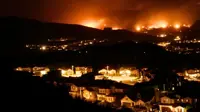Health risks from wildfires to increase under climate change
20 Aug 2016
A surge in major wildfire events in the western United States as a consequence of climate change will expose tens of millions of Americans to high levels of air pollution in the coming decades, according to a new Yale-led study conducted with collaborators from Harvard.
The researchers estimated air pollution from past and projected future wildfires in 561 western counties, and found that by mid-century more than 82 million people will experience ''smoke waves,'' or consecutive days with high air pollution related to fires.
The regions likely to receive the highest exposure to wildfire smoke in the future include northern California, western Oregon, and the Great Plains.
The findings, published in the journal Climatic Change, point to the need for new or modified wildfire management and evacuation programs in the nation's high-risk regions, said Jia Coco Liu, a recent PhD graduate at the Yale School of Forestry & Environmental Studies (F&ES) and lead author of the study.
''Our study illustrates that smoke waves are likely to be longer, more intense, and more frequent under climate change,'' Liu says. ''This raises critical health, ecological, and economic concerns. Identifying communities that will be most affected in the future will inform development of fire management strategies and disaster preparedness programs.''
Other authors include Michelle Bell, the Mary E. Pinchot Professor of Environmental Health at F&ES; Keita Ebisu, a former doctoral student with Bell; as well as colleagues at Harvard, Colorado State University, and the University of Michigan.
Smoke from wildfires, which are becoming more frequent and intense in the US West as the climate changes, contains large amounts of fine particulate matter, or PM2.5, which can have profound impacts on human health.
But while wildfires are estimated to contribute about 18 per cent of the total PM2.5 emissions in the United States, many questions remain about how these emissions will affect human populations, including how overall air quality will be affected, how these levels will change under climate change, and which regions are most likely to be impacted.
Using sophisticated atmospheric and climate models, the researchers estimated the levels of PM2.5 directly attributable to wildfires during a recent six-year period, 2004 to 2009, as well as under projected future climate change conditions (2046 to 2051).
Twenty counties that are currently free from smoke waves are expected to experience at least one in the future six-year period. The length of the smoke wave season is estimated to increase by an average of 15 days in more than 62.5 per centof the counties.
About 56 per cent of the counties currently affected by smoke waves - including most located in the forests of the northern Rocky Mountains and coastal counties - will likely face more intense smoke waves in the future. About 19 per cent will have less intense smoke waves.
The researchers also developed an interactive map to illustrate their findings.
''We hope these results will advance the understanding of the impacts of an increasing threat of wildfire smoke, and aid in the design of early warning systems, fire suppression policies, and public health programs,'' Liu said.



.webp)
.webp)

.webp)
.webp)

























